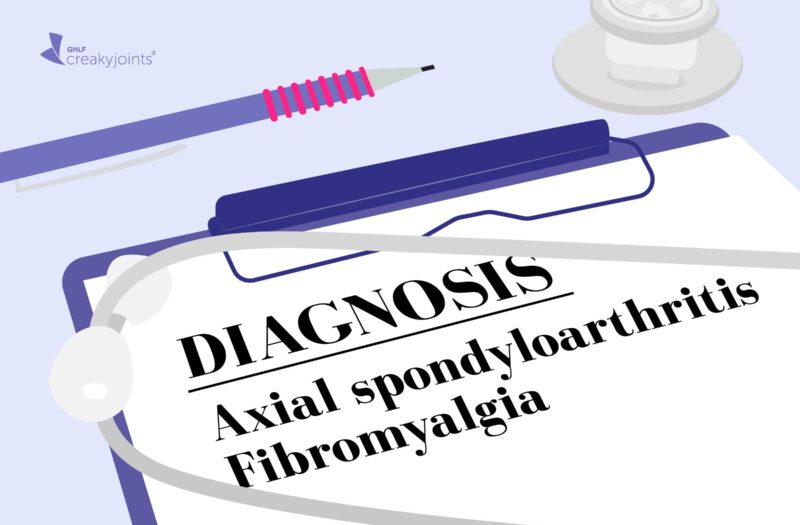If you have axial spondyloarthritis (axSpA), you are no stranger to intense pain caused by this inflammatory arthritis.
However, the reason for your pain may be different if you also have fibromyalgia in addition to axSpA, according to results from a new study from British and Norwegian researchers, which further connects the dots between these two conditions that can result in overlapping pain.
The study suggests that identifying fibromyalgia as a co-condition in patients with axial spondyloarthritis can affect a patient’s treatment and outcomes.
Although rheumatologists have known that people with axSpA are at a higher risk for developing fibromyalgia, they haven’t known as much about how these two conditions affect people over time.
Fibromyalgia vs. Axial Spondyloarthritis
Fibromyalgia is thought to result from changes in the way your central nervous system process pain. According to the Mayo Clinic, “fibromyalgia amplifies painful sensations by affecting the way your brain and spinal cord process painful and nonpainful signals.”
In contrast, axSpA pain is due to inflammation and immune system overactivity. Anti-inflammatory medication and medications that tamp down this immune system overactivity (such as biologics) are needed to manage this type of pain.
Axial spondyloarthritis is an umbrella term for types of inflammatory arthritis that primarily affect the spine and the sacroiliac (SI) joints that connect the lower spine to the pelvis, resulting in pain in the lower back, hips, and buttocks. There are two subtypes of axSpA:
“Non-radiographic” means that damage to the joints is not visible on X-ray. When changes to the vertebrae (the bones of the spine) or SI joints don’t show any changes on an X-ray, that’s known as nr-axSpA.
It has been estimated that around 15 percent of people with axSpA also have fibromyalgia, according to a 2019 study in the journal Best Practice & Research Clinical Rheumatology. It may also be the case that some patients are diagnosed with only fibromyalgia when they may also or instead have axial spondyloarthritis.
How Fibromyalgia Affects AxSpA Symptoms
When you have axial spondyloarthritis, you may experience daily pain. Your lower back, neck, hips, and other joints may feel stiff and achy when you wake up and may only feel better when you move around. If you also have fibromyalgia, you may feel pain throughout your body. Both conditions can contribute to fatigue, brain fog, depression and anxiety, and difficulty doing everyday activities. Fibro can exacerbate axSpA and lead to a worse quality of life in people with both conditions.
The study authors had previously shown that “patients with axSpA and fibromyalgia report higher levels of axSpA disease activity, depression, anxiety, fatigue, and work interference, compared to patients with axSpA alone.”
However, the authors also note that fibromyalgia may not be a permanent state — it can get worse or get better. They wanted to better understand what factors may be associated with causing or relieving fibromyalgia in axSpA patients, in order to help improve treatment and overall well-being.
Which axSpA Patients Are More Likely to Develop Fibromyalgia?
Researchers studied 801 axSpA patients who were recruited from 83 rheumatology care centers across the United Kingdom between December 2012 and December 2017.
Some of these patients began taking tumor necrosis factor (TNF) inhibitor biologics for their axSpA after the study began. TNF inhibitors are biologic drugs that target the immune system protein tumor necrosis factor, which can cause inflammation in a number of conditions, including axial spondyloarthritis.
Patients were screened for the presence of fibromyalgia at their first visit and at follow-up visits throughout the study. Researchers also collected a lot of other patient data about axSpA symptoms, comorbidities, measures of inflammatory markers, and patient-reported responses to questions about disease activity, function, anxiety and depression, fatigue, and sleep disturbance.
From these data, the researchers found two striking trends:
- Patients with axSpA who developed fibromyalgia tended to not have the HLA-B27 gene known to be associated with axSpA in some patients. They also had high axSpA disease activity, high widespread pain, and high levels of anxiety and depression.
- Patients with axSpA who developed and then recovered from fibromyalgia after starting TNF biologics reported low trouble with function, low levels of widespread pain, and low sleep disturbance.
The Role of axSpA Disease Activity and Biologic Treatment
These findings show that axSpA patients with the highest risk of having fibromyalgia had high levels of disease activity and widespread pain. When these patients were treated with a TNF inhibitor biologic, they subsequently had lower levels of widespread pain and were more likely to recover from fibromyalgia.
The researchers further suggest that fibromyalgia may have developed as a long-term consequence of axSpA disease activity in these patients, noting this explanatory path is also supported by findings from this study showing that a subgroup of patients who self-reported high disease activity at baseline seemed to be more strongly associated with fibromyalgia development.
When patients report axSpA disease activity scores that are high despite low levels of inflammation or other positive responses to treatment, doctors should consider that this could indicate fibromyalgia. “Disentangling” the two conditions can help doctors more effectively target therapy for each condition, the researchers suggest.
What This Means for You
If you have axSpA and find that your pain is increasing or spreading to other parts of your body, talk to your doctor and discuss whether fibromyalgia may be a factor.
Remember that high axSpA disease activity may be driving fibromyalgia pain. This is why it is so important for you to be able to describe your pain accurately to your rheumatologist. While there are no specific tests to diagnose fibromyalgia, the hallmark symptom is widespread pain throughout your body. That means axSpA pain may be more easily identified in specific sources, while fibromyalgia pain is more widespread.
If you have fibromyalgia and axSpA, you and your doctor will need to work together to manage both of these conditions at the same time. AxSpA needs to be treated with medication to reduce inflammation (such as NSAIDs or biologics); fibromyalgia is often treated with a combination of medications (including antidepressants and antiseizure medication) and lifestyle changes. Read more here about fibromyalgia treatment options.
Although axSpA and fibromyalgia can often overlap, seeking your doctor’s help to manage axSpA inflammation may help to better manage and even resolve the fibromyalgia pain you have developed that could be preventing you from living your best life.
Track Your AxSpA Symptoms with ArthritisPower
Join CreakyJoints’ patient-centered research registry and track symptoms like fatigue and pain. Learn more and sign up here.
This educational resource was made possible with support from UCB, a global biopharmaceutical company focused on neurology and immunology.
Central Pain Syndrome Information Page. National Institute of Neurological Disorders and Stroke.
https://www.ninds.nih.gov/Disorders/All-Disorders/Central-Pain-Syndrome-Information-Page.
Fibromyalgia. American College of Rheumatology.
https://www.rheumatology.org/I-Am-A/Patient-Caregiver/Diseases-Conditions/Fibromyalgia.
Macfarlane GJ, et al. Co-Occurrence and Characteristics of Patients With Axial Spondyloarthritis Who Meet Criteria for Fibromyalgia: Results From a UK National Register. Arthritis & Rheumatology. November 2017. doi: https://doi.org/10.1002/art.40185.
Macfarlane GJ, et al. Influence of co-morbid fibromyalgia on disease activity measures and response to tumour necrosis factor inhibitors in axial spondyloarthritis: results from a UK national register. Rheumatology. November 2018. doi: https://doi.org/10.1093/rheumatology/key206.
Moltó A, et al. Evaluation of the impact of concomitant fibromyalgia on TNF alpha blockers’ effectiveness in axial spondyloarthritis: results of a prospective, multicentre study. Annals of the Rheumatic Diseases. April 2018. doi: https://doi.org/10.1136/annrheumdis-2017-212378.
Provan SA, et al. The changing states of fibromyalgia in patients with axial spondyloarthritis: results from BSRBR-AS. Rheumatology (Oxford). January 2021. doi: https://doi.org/10.1093/rheumatology/keaa888.
Spondyloarthritis. American College of Rheumatology. https://www.rheumatology.org/I-Am-A/Patient-Caregiver/Diseases-Conditions/Spondyloarthritis.
Zao SS, et al. The prevalence and impact of comorbid fibromyalgia in inflammatory arthritis. Best Practice & Research Clinical Rheumatology. June 2019. doi: https://doi.org/10.1016/j.berh.2019.06.005.






